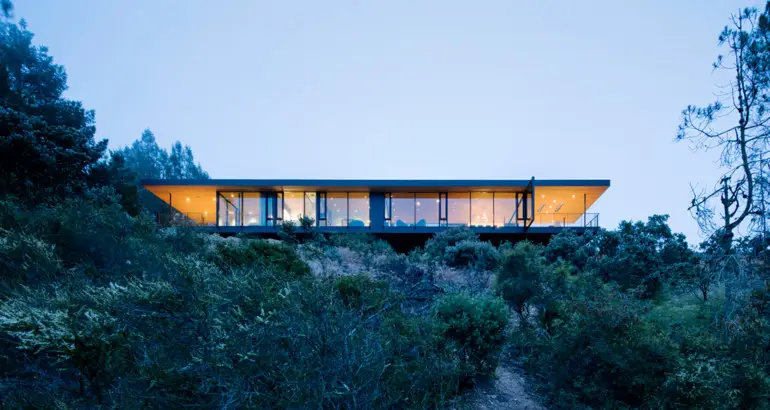A house destroyed in the Mayacamas foothills will rise again.
“WE SHED A LOT OF TEARS along with our clients,” architect Joshua Aidlin of the San Francisco firm Aidlin Darling Design says.
Less than a year after it was completed in 2016, the 3,100-square-foot weekend home the firm designed for David Rice and his partner, Barry Mehew, was consumed by wildfires. Set on a hillside near Glen Ellen, the home had taken “four years to design and build,” project architect Cherie Lau recalls with a sigh.
But Rice, who heads the San Francisco tech startup behind Life360 — an app that connects family members during a crisis — reassured everyone involved that, unlike others less fortunate, they could and would rebuild. And, gratifyingly for the designers, he and Mehew wanted precisely the same house again.
Rice grew up in San Jose but has lived in Europe, Asia and other parts of the United States; he met Mehew, a financial consultant from London, on vacation 18 years ago in Cape Town. Living in England, as well as their experiences around the globe, helped hone their taste for the kind of spare, international-style environment that Aidlin and Lau created for them.
During the last 18 years the couple has tried to incorporate a similar modern sensibility into their four-story Victorian home in San Francisco with some success, but “we were always limited by its physical footprint,” Rice says. “In the country, without such constraints we had exactly what we wanted.”
A winding dirt road cuts across their 26-acre property up to the ridge where their single-story getaway home once commanded panoramic views of Sonoma Valley to the west.

The structure consists of two small standing-seam zinc-clad volumes, set slightly apart on the hill in a north-south axis and linked by a long glazed box of a floating bridge held aloft on slender steel pilotis (piers). Modular, practical, with no two-story glass spaces, the relatively low-budget design had the playful quality of “a garden pavilion that embraced the outdoors,” Aidlin says.

The glazed bridge contained south-facing living and dining areas with modern furnishings, a library in the middle, and the north-facing master suite; retractable glass doors at each end opened to spacious decks shaded by flat, cantilevered, heat-reflecting albedo roofs. The tubular bridge had openings at each end providing cross-ventilation; its cedar wood-clad ceilings and distressed oak floors contrasted pleasingly with the sleeker interiors of the zinc-clad sections north and south. The north structure, with concrete floors and white-painted walls, had two guest rooms, and the south one had a galley kitchen with retractable Fleetwood aluminum doors opening onto a deck and a swimming pool.
“As soon as you arrived in the concrete courtyard on the east side and entered through the front door, you were on a rusticated wood floor,” Aidlin adds. “You saw, felt and perhaps even smelled the difference.”


Pine trees planted by Boy Scouts to reforest the west hill slope after a similar fire during the ’60s made the building seem like a treehouse, but the trees only added to the intensity of the blaze that took nearly everything in its path, leaving behind a moonscape of white ash.
“We were in the city when the security system sent us an alert at 1 a.m. that our country house was dying. The last signal said that the propane tank was empty,” Rice recalls.
Only the pool, deck and built-ins at the south end of the building survived, along with the hedges and car court. “It is surreal,” Lau says. “One part of the site where the swath of fire did not cut through is still lush.” The intact sections will be reintegrated when the property takes shape again.

The structure will cost exponentially more to build this time around, in part due to more stringent building and fire codes, but even those are unlikely to prevent such a tragedy from ever happening again. “Nothing, not even a concrete house, could have survived in such a situation, because windows are always the weakest line of defense,” Aidlin explains.



The low-maintenance zinc cladding, which created the visual illusion of fire resistance, also could not withstand the force of the fire, which grabbed extra fuel — patches of dry wild grass — as it advanced up the hill.
“Only buildings on heavily watered lots survived,” Aidlin says. “Soaked vegetation prevented the fire from reaching some houses. But lawns are not ecologically smart, and a wide clearing as a fire barrier is not attractive either.”
For now, the danger is past, because Rice and Mehew’s woods are gone and it will be decades before less fire-prone native manzanitas, oaks and madrones they have replanted will mature.
Still, the site is beautiful.
“The silver lining is that without the trees the view is even more spectacular,” Lau says.


The only hurdle to overcome right now is cost, and to reduce that would mean compromising on the custom details, built-in cabinetry and materials that gave the spectacular, glowing structure its identity. “Yes, it could be rebuilt with stucco and plasterboard,” Aidlin says. “But that just wouldn’t feel the same.”
Resources
ARCHITECT and INTERIOR DESIGN by Aidlin Darling Design aidlindarlingdesign.com; principals Joshua Aidlin and David Darling, project architect Cherie Lau, project team Michael Pierry
LIVING ROOM Chair, Label Van den Berg, label.nl
MASTER BEDROOM Bed, De La Espada, delaespada.com, hanging bedside lamps, Naomi Paul, naomipaul.co.uk
MASTER BATHROOM Bathtub, Wetstyle, wetstyle.ca
This article originally appeared in Spaces’s print edition under the headline: “Déjà Vu”.

